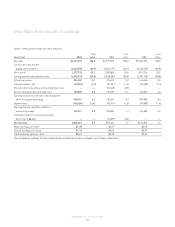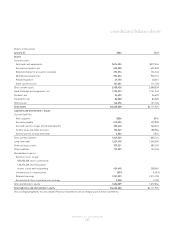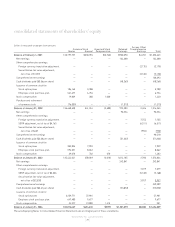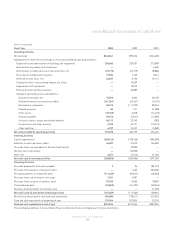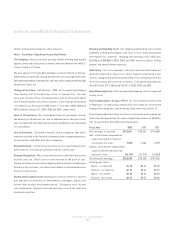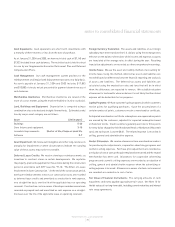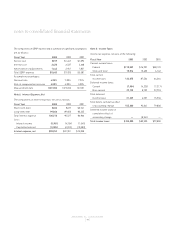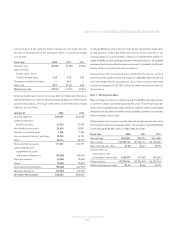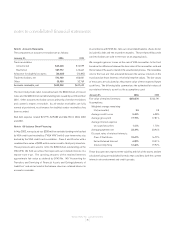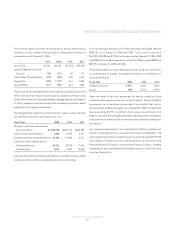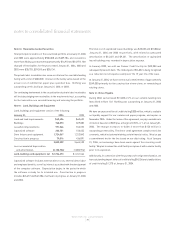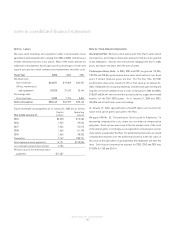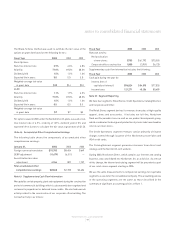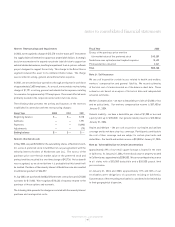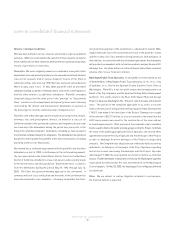Nordstrom 2003 Annual Report Download - page 38
Download and view the complete annual report
Please find page 38 of the 2003 Nordstrom annual report below. You can navigate through the pages in the report by either clicking on the pages listed below, or by using the keyword search tool below to find specific information within the annual report.
NORDSTROM, INC. and SUBSIDIARIES
[36 ]
Note 8: Accounts Receivable
The components of accounts receivable are as follows:
January 31, 2004 2003
Trade receivables:
Unrestricted $25,228 $15,599
Restricted 589,992 613,647
Allowance for doubtful accounts (20,320) (22,385)
Trade receivables, net 594,900 606,861
Other 38,958 32,769
Accounts receivable, net $633,858 $639,630
The restricted private label receivables back the $300 million of Class A
notes and the $200 million variable funding note issued by us in November
2001. Other accounts receivable consist primarily of vendor receivables
and cosmetic rebates receivable. As all vendor receivables are fully
earned at period end, no allowance for doubtful vendor receivables has
been recorded.
Bad debt expense totaled $27,975, $29,080 and $34,750 in 2003, 2002
and 2001.
Note 9: Off-balance Sheet Financing
In May 2002, we replaced our $200 million variable funding note backed
by VISA credit card receivables ("VISA VFN") with 5-year term notes also
backed by the VISA credit card receivables. Class A and B notes with a
combined face value of $200 million were issued to third party investors.
These proceeds were used to retire the $200 million outstanding on the
VISA VFN. We hold securities that represent our retained interests in a
master note trust. The carrying amounts of the retained interests
approximate fair value as defined by SFAS No. 140 “Accounting for
Transfers and Servicing of Financial Assets and Extinguishments of
Liabilities” and are included in the balance sheets as retained interest in
accounts receivable.
In accordance with SFAS No. 140, our consolidated balance sheets do not
include this debt and the related receivables. These related VISA credit
card receivables are sold to the trust on an ongoing basis.
We recognize gains or losses on the sale of VISA receivables to the trust
based on the difference between the face value of the receivables sold and
the fair value of the assets created in the securitization process. The receivables
sold to the trust are then allocated between the various interests in the
trust based on those interests' relative fair market values. The fair values
of the assets are calculated as the present value of their expected future
cash flows. The following table summarizes the estimated fair values of
our retained interests as well as the assumptions used:
January 31, 2004 2003
Fair value of retained interests: $270,570 $124,791
Assumptions:
Weighted average remaining
life (in months) 2.5 2.8
Average credit losses 5.45% 6.38%
Average gross yield 17.79% 17.81%
Average interest expense
on issued securities 1.41% 1.70%
Average payment rate 23.39% 20.94%
Discount rates of retained interests:
Class C Certificate 10.67% 16.79%
Seller Retained Interest 6.80% 10.51%
Interest Only Strip 12.60% 19.92%
These discount rates represent the volatility and risk of the assets and are
calculated using an established formula that considers both the current
interest rate environment and credit spreads.
notes to consolidated financial statements


